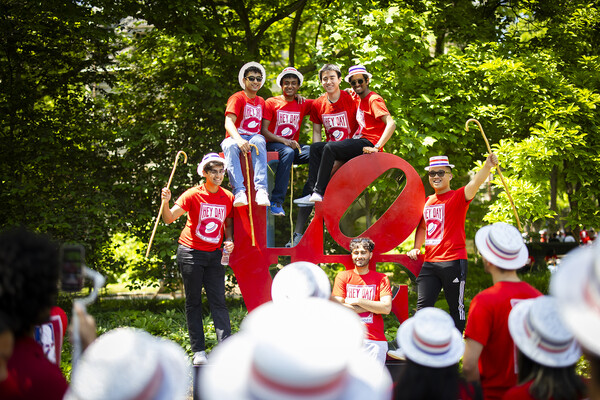
Walking around Penn’s campus, it’s easy to spot the iconic works of art that symbolize the University: “Ben on the Bench,” the “Split Button,” and the “LOVE” sculpture among them. But look a little closer at buildings like College Hall and low walls around Penn Commons and elsewhere, and small marble shields, oval signs, and rectangular slabs become apparent, with not much visually in common save the engraved sprig of ivy and the words “Ivy Day.”
These Ivy Stones have graced Penn’s campus since 1873, a tradition that began as a way for students to mark the University’s move to West Philadelphia and to christen the newly built College Hall, according to a history compiled by University Archives.
These days, the fourth-year class board members, with help from Rodney Robinson, associate director of activities in the Office of Student Affairs, oversee a competition open to fourth-years to design the class stone.
“No one has to be an artist; it could be hand-drawn on a napkin. We consider all submissions,” says Robinson, who has been advising class boards on the stones since 1999. The only limiting factor is it can’t be too intricate, which could make the job tricky for the stone carver.
Traditionally, the stone has been unveiled at Ivy Day, held the Saturday before Commencement, when fourth-year honor awards recipients are announced, as well as other award recipients. This year, however, the tradition changed to present the stone’s design during Baccalaureate, so more students would have a chance to view the official stone in person and so pins bearing the likeness of the 2024 Ivy Stone could be handed out to the class, Robinson says.
“This way, more students will see it, and more people are going to have a connection to it, which is exciting,” he says.
With more than 200 Ivy Day stones installed across the campus, each stone tells a story of the graduating class that contributed it, adding to the tapestry of Penn’s legacy.
But why are there more than 200? For a few decades, students doubled up on the presentation of Ivy Stones. In 1885, two stones were dedicated, one for arts and one for sciences, both on the west front of College Hall. From 1926 to 1967, the men’s and women’s classes created separate stones. The women’s stones can be found on Fisher-Bennett Hall, which was the home of the College for Women, and Hill House, the first women’s dormitory, Robinson says.
A look at the stones can feel like a glimpse into a mini time capsule of trends in typography and iconography: the Art Deco style of the 1930s stones, the warplane engraved in the 1944 stone, the World War II army helmet and words “Vivere Militare Est" (“to live is to fight”) in the 1945 stone, the pink marble stones that were choices from the 1990s and early 2000s. One of the largest is the 1998 Ivy Stone, installed in the entryway floor of the then-newly-built Penn Bookstore.
Robinson himself could be called the modern-day keeper of the stones. In recent years, when first construction and then the pandemic delayed installation of five stones, he housed them in his office, where they lived under a couch. Last summer, a work truck ran into a low wall that featured the 2001 and 2003 stones, and they fell to the ground. Robinson took it upon himself to head over and pick them up, keeping them safe again depositing them under his couch until the repairs were ready for reinstallation.
As for which stone is his favorite, he says he was so excited when the Class of 2005 chose to make the stone in the shape of a “P” for Penn.
“It’s so great, and my big push for a few years was trying to convince other classes to make an ‘E’ and then we could move on to two ‘N’s’ Unfortunately, my great idea hasn’t gotten any traction, so I’ve stopped pushing it,” he says. “No one wants to be an ‘E,’ it seems.”
For him, the stones are a special souvenir of each class.
“I find the stones to be a great way to mark a great class and celebrate it,” he says.









